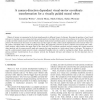Free Online Productivity Tools
i2Speak
i2Symbol
i2OCR
iTex2Img
iWeb2Print
iWeb2Shot
i2Type
iPdf2Split
iPdf2Merge
i2Bopomofo
i2Arabic
i2Style
i2Image
i2PDF
iLatex2Rtf
Sci2ools
SGAI
2005
Springer
2005
Springer
A Camera-Direction Dependent Visual-Motor Coordinate Transformation for a Visually Guided Neural Robot
Objects of interest are represented in the brain simultaneously in different frames of reference. Knowing the positions of one’s head and eyes, for example, one can compute the body-centred position of an object from its perceived coordinates on the retinae. We propose a simple and fully trained attractor network which computes head-centred coordinates given eye position and a perceived retinal object position. We demonstrate this system on artificial data and then apply it within a fully neurally implemented control system which visually guides a simulated robot to a table for grasping an object. The integrated system has as input a primitive visual system with a what– where pathway which localises the target object in the visual field. The coordinate transform network considers the visually perceived object position and the camera pan-tilt angle and computes the target position in a body-centred frame of reference. This position is used by a reinforcement-trained network to d...
| Added | 28 Jun 2010 |
| Updated | 28 Jun 2010 |
| Type | Conference |
| Year | 2005 |
| Where | SGAI |
| Authors | Cornelius Weber, David Muse, Mark Elshaw, Stefan Wermter |
Comments (0)

